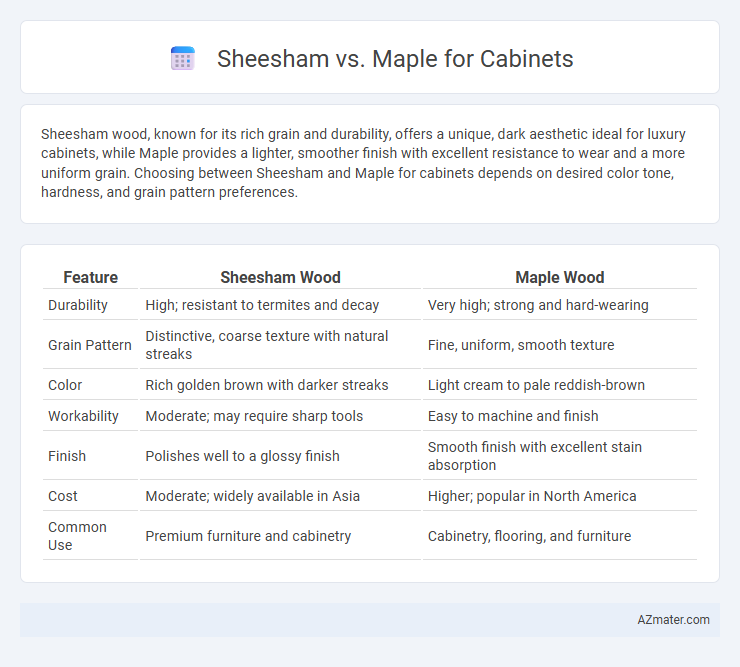Sheesham wood, known for its rich grain and durability, offers a unique, dark aesthetic ideal for luxury cabinets, while Maple provides a lighter, smoother finish with excellent resistance to wear and a more uniform grain. Choosing between Sheesham and Maple for cabinets depends on desired color tone, hardness, and grain pattern preferences.
Table of Comparison
| Feature | Sheesham Wood | Maple Wood |
|---|---|---|
| Durability | High; resistant to termites and decay | Very high; strong and hard-wearing |
| Grain Pattern | Distinctive, coarse texture with natural streaks | Fine, uniform, smooth texture |
| Color | Rich golden brown with darker streaks | Light cream to pale reddish-brown |
| Workability | Moderate; may require sharp tools | Easy to machine and finish |
| Finish | Polishes well to a glossy finish | Smooth finish with excellent stain absorption |
| Cost | Moderate; widely available in Asia | Higher; popular in North America |
| Common Use | Premium furniture and cabinetry | Cabinetry, flooring, and furniture |
Introduction to Sheesham and Maple Cabinets
Sheesham cabinets, crafted from Indian rosewood, are prized for their rich grain, durability, and natural resistance to decay, making them a premium choice for long-lasting furniture. Maple cabinets offer a smooth, consistent texture with a lighter hue, known for their strength and ease of staining, providing versatile design options. Both woods bring unique benefits to cabinetry, with Sheesham emphasizing natural beauty and Maple delivering modern simplicity.
Sheesham Wood: Key Characteristics
Sheesham wood, known for its rich grain patterns and natural durability, offers exceptional resistance to decay and termites, making it ideal for long-lasting cabinets. Its dense texture provides a smooth finish, enhancing the aesthetic appeal and strength of cabinetry. Compared to maple, Sheesham's unique color variations and hardness ensure both functionality and elegance in woodwork.
Maple Wood: Key Characteristics
Maple wood is prized for its smooth, fine grain and light, uniform color, making it ideal for contemporary cabinet designs that require a clean, polished look. Its exceptional hardness and durability ensure resistance to dents and scratches, providing longevity for kitchen and storage cabinetry. Maple also accepts stains and finishes well, allowing versatile customization while maintaining its structural integrity in cabinetry applications.
Durability Comparison: Sheesham vs Maple
Sheesham wood offers exceptional durability due to its natural resistance to moisture, termites, and fungal attacks, making it ideal for long-lasting cabinets. Maple wood, known for its hardness and dense grain, provides strong impact resistance and wearability, ensuring cabinets maintain structural integrity over time. Comparing the two, Sheesham's superior natural oils enhance moisture resistance, while Maple's hardness delivers better resistance to scratches and dents, resulting in durable cabinet options tailored to different environmental conditions.
Aesthetic Differences: Grain, Color, and Texture
Sheesham wood features a rich, dark brown to golden hue with prominent, swirling grain patterns that create a distinctively rustic and warm aesthetic for cabinets. Maple offers a lighter, more uniform color ranging from creamy white to light reddish-brown, with a smoother, fine grain that lends a clean and contemporary look. The texture of Sheesham is naturally coarse and tactile, enhancing its artisanal feel, whereas Maple's even texture provides a sleek and polished finish ideal for modern cabinetry.
Cost Analysis: Sheesham vs Maple Cabinets
Sheesham cabinets typically cost more than maple due to the wood's natural oil content and durability, which increases its market value. Maple cabinets provide a more budget-friendly option while offering strength and smooth grain suitable for various finishes. Choosing between Sheesham and maple hinges on balancing cost considerations with desired aesthetics and long-term durability.
Maintenance and Care Considerations
Sheesham wood requires regular polishing and oiling to maintain its natural luster and prevent drying or cracking, while Maple demands less frequent maintenance due to its dense, smooth grain that resists moisture and stains. Sheesham is prone to termite attacks and may need preventive treatments, whereas Maple is generally more resilient and easier to clean with mild detergents. Choosing between Sheesham and Maple for cabinetry hinges on balancing Sheesham's rich aesthetic appeal with the more durable, low-maintenance nature of Maple.
Environmental Impact and Sustainability
Sheesham wood, also known as Indian Rosewood, is a sustainable choice due to its fast growth and widespread availability, reducing pressure on natural forests. Maple, primarily sourced from North American forests, often comes with certifications like FSC that ensure responsible harvesting and forest management. Both woods offer durability and aesthetic appeal, but Sheesham's ability to regenerate quickly makes it a more environmentally friendly option for cabinets focused on sustainability.
Versatility and Usage in Cabinetry
Sheesham wood offers exceptional durability and a rich, natural grain, making it highly versatile for cabinetry that requires strength and aesthetic appeal. Maple's fine, uniform texture and smooth finish allow for precise machining and customization, ideal for sleek, modern cabinet designs. Both woods excel in usage for cabinetry, with Sheesham favored for traditional, robust pieces and Maple preferred for contemporary, refined applications.
Final Verdict: Which Wood is Better for Cabinets?
Sheesham wood offers superior durability and natural resistance to termites and fungal attacks, making it ideal for long-lasting cabinets, while maple provides a smooth grain and lighter finish favored for modern, sleek cabinetry. Sheesham's rich, darker tones enhance traditional and rustic aesthetics, whereas maple's consistent color and fine texture suit contemporary designs. For cabinets prioritizing strength and durability with a warm, luxurious appearance, Sheesham is better; for those seeking a clean, lighter look with easier customization, maple is preferable.

Infographic: Sheesham vs Maple for Cabinet
 azmater.com
azmater.com